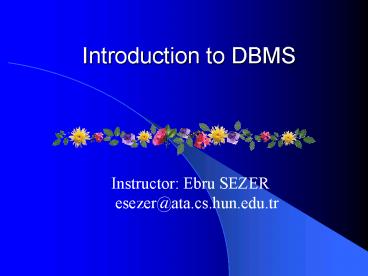Introduction to DBMS - PowerPoint PPT Presentation
1 / 15
Title:
Introduction to DBMS
Description:
External Key: Key which is composed aspects of physical storage of record ... of entity set is stored in files in physical structure , in tables in logical structure ... – PowerPoint PPT presentation
Number of Views:87
Avg rating:3.0/5.0
Title: Introduction to DBMS
1
Introduction to DBMS
- Instructor Ebru SEZEResezer_at_ata.cs.hun.edu.tr
2
- ENTITY SET Set of similiar objects
- Employees of companies is employee entitiy
set - ATTRIBUTE Description of entities
- For employee entity number, name, deptno,
age, adr, salary..etc are attributes. - RECORDStores whole information of an entity
- Fixed /variable length records
- Fixed/variable type records (Ex.
ThesisLesson Stage Of BS) - FILE Organization of whole datas of one entity
set - Employee file is keeps all employees
record
3
- Size of file
- Operation on Files
- Read
- Write
- Types Of Acces
- Sequential
- Random (Direct)
- KEY One or more field to used for retrieve or
sort file - Primary Key One or more field which van take
unique value for an entity - External Key Key which is composed aspects of
physical storage of record
4
Introduction to Information Sys
- Electronic form of data must be
- in collection
- organized
- stored
- They must be permanently
- Maintained
- Quickly updated and show changes
- Two main aspect of info sys.
- Capacity to management to perform necessary
functions - Availability of informations
5
DATABASE
- Database Collection organization of related
data - Represents some aspects of real world called
miniworld - Logically coherent collection fo data. Random
assortment of data con not reffered as db. - Designed, builtin populated with data for
specific purposes - Table Basic logical unit for store data.
- Stores whole information of an entity set
- Defined by name and coloumns (attribute) set
- Can be altered after creation
- You can think that
- Info. of entity set is stored in files in
physical structure , in tables in logical
structure
6
Sample Tables
7
What Is a DBMS?
- A Database Management System (DBMS) is a software
package designed to store and manage databases. - With DBMS
- Supports large volumes
- Data independence and efficient access.
- Reduced application development time.
- Data integrity and security.
- Concurrent access, recovery from crashes.
8
Structure of a DBMS
These layers must consider concurrency control
and recovery
- A typical DBMS has a layered architecture.
- The figure does not show the concurrency control
and recovery components. - This is one of several possible architectures
each system has its own variations.
9
Sample Database
10
Levels of Abstraction
- Many views, single conceptual (logical) schema
and physical schema. - Views describe how users see the data.
- Conceptual schema defines logical structure
- Physical schema describes the files and indexes
used.
View 1
View 2
View 3
Conceptual Schema
Physical Schema
11
Exp University Database
- Conceptual schema
- Students(sid string, name string, login
string, - age integer, gpareal)
- Courses(cid string, cnamestring,
creditsinteger) - Enrolled(sidstring, cidstring, gradestring)
- Physical schema
- Relations stored as unordered files.
- Index on first column of Students.
- External Schema (View)
- Course_info(cidstring,enrollmentinteger)
12
Data Independence
- Applications insulated from how data is
structured and stored. - Logical data independence Protection from
changes in logical structure of data. - Physical data independence Protection from
changes in physical structure of data.
- One of the most important benefits of using a
DBMS!
13
People who deal with databases
- Database implimentors
- End users and DBMS vendors
- DB application programmers
- E.g. smart webmasters
- Database administrator (DBA)
- Designs logical /physical schemas
- Handles security and authorization
- Data availability, crash recovery
- Database tuning as needs evolve
Must understand how a DBMS works!
14
Important Reason for looking inside db
- DBAs must know underlying technology to make
decision - (System installing, parameter setting)
- Decide best configuration of an application
15
Database Languages(ext.)
- DDL define logical physical external schemas
- DMLquerying and updating db instances
- Host Languages C, C, Fortran..etc
- Tools
- Use interface of designers to form DML query
- Oracle designer, Power designer































